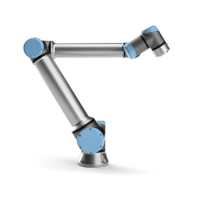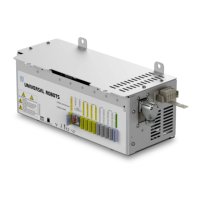Glossary
Stop Category 0: Robot motion is stopped by immediate removal of power to the
robot. It is an uncontrolled stop, where the robot can deviate from the pro-
grammed path as each joint brake as fast as possible. This protective stop is
used if a safety-related limit is exceeded or in case of a fault in the safety-
related parts of the control system. For more information, see ISO 13850 or
IEC 60204-1.
Stop Category 1: Robot motion is stopped with power available to the robot to achieve
the stop and then removal of power when the stop is achieved. It is a con-
trolled stop, where the robot will continue along the programmed path. Power
is removed as soon as the robot stands still. For more information, see ISO 13850
or IEC 60204-1.
Stop Category 2: A controlled stop with power left available to the robot. The safety-
related control system monitors that the robot stays at the stop position. For
more information, see IEC 60204-1.
Category 3: The term “Category” should not be confused with the term “Stop Cate-
gory”. “Category” refers to the type of architecture used as basis for a certain
“Performance Level”. A significant property of a “Category 3” architecture is
that a single fault cannot lead to loss of the safety function. For more informa-
tion, see ISO 13849-1.
Performance Level: A Performance Level (PL) is a discrete level used to specify the
ability of safety-related parts of control systems to perform a safety functions
under foreseeable conditions. PLd is the second highest reliability classifica-
tion, meaning that the safety function is extremely reliable. For more informa-
tion, see ISO 13849-1.
Diagnostic coverage (DC): is a measure of the effectiveness of the diagnostics imple-
mented to achieve the rated performance level. For more information, see
ISO 13849-1.
MTTFd: The Mean time to dangerous failure (MTTFd) is a value based on calcu-
lations and tests used to achieve the rated performance level. For more infor-
mation, see ISO 13849-1.
Integrator: The integrator is the entity that designs the final robot installation. The
integrator is responsible for making the final risk assessment and must ensure
that the final installation complies with local laws and regulations.
Risk assessment: A risk assessment is the overall process of identifying all risks and
reducing them to an appropriate level. A risk assessment should be docu-
mented. Consult ISO 12100 for further information.
Collaborative robot application: The term “collaborative” refers to collaboration be-
tween operator and robot in a robot application. See precise definitions and
descriptions in ISO 10218-1 and ISO 10218-2.
Version 3.4.5
Copyright © 2009–2017 by Universal Robots A/S. All rights reserved.
III-27 CB3

